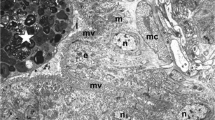Summary
Different embryonic and postembryonic stages of capsular fluid containing cells of the midgut region in Lymnaea stagnalis L. are described. These cells arise from the archenteron and take up a great quantity of capsular fluid in a large vacuole. At hatching the diameter of the cells mesures 160-200 μ. In opposition to the opinion of Cumin (1972) these store-cells do not transform into cells of the adult midgut; they degenerate in the early postembryonic period. The degeneration starts in a diminuishing of the cell size. Later on autophagic vacuoles can be observed in the cytoplasm, the membrane of the large vacuole breaks up and the nucleus begins to degenerate. Membran bounded granules, which can be observed mainly in early postembryonic stages, are thought to be primary lysosomes. In a last phase the cells seem to be taken up by indifferent cells of the adult midgut.
Zusammenfassung
Verschiedene embryonale und postembryonale Entwicklungsstadien der primären — vom Urdarm abstammenden — Eiklarzellen von Lymnaea stagnalis werden beschrieben. Bis zum Schlüpfen der Embryonen nehmen diese Zellen große Mengen perivitelline Flüssigkeit auf und erreichen schließlich eine Höhe von 160–200 μ. Entgegen der Auffassung von Cumin (1972) findet in der frühen Postembryonalperiode nicht eine Neudifferenzierung der Eiklarzellen zu adulten Mitteldarmdrüsenzellen, sondern ihre Degeneration statt. Die Rückbildungsphase setzt durch eine Verkleinerung der Zellen ein. Anschließend treten im Cytoplasma autophage Vakuolen auf; die Eiklarvakuolenmembran zerfällt, und in einem späteren Zeitpunkt degeneriert auch der Kern. Kleine osmiophile membranbegrenzte Körper, die vor allem postembryonal auftreten, werden als primäre Lysosomen gedeutet. In einer letzten Phase scheinen die Reste der Eiklarzellen von undifferenzierten Zellen der adulten Mitteldarmdrüse aufgenommen zu werden.
Similar content being viewed by others
Abbreviations
- A:
-
A-Zelle
- AH:
-
Atemhöhle
- Au:
-
Auge
- aV:
-
autophage Vakuole
- B:
-
B-Zelle
- D:
-
Dotterkorn
- Da:
-
Darm
- EL:
-
Eiklarsacklumen
- ER:
-
Endoplasmatisches Reticulum
- EV:
-
Eiklarvakuole
- EZ:
-
Eiklarzelle
- F:
-
Fuß
- G:
-
Golgiapparat
- Ga:
-
Ganglion
- GL:
-
Gastrallumen
- kEP:
-
kleinzellige Entodermplatte
- K:
-
Kern
- L:
-
primäre Lysosomen
- M:
-
Mitochondrium
- Ma:
-
Magen
- MD:
-
Mitteldarmdrüse
- Oe:
-
Oesophag
- PV:
-
Pinocytosevesikel
- S:
-
Schale
- St:
-
Stomodäum
- ZF:
-
Zellfortsatz
Literatur
Adam, H., Czihak, G.: Arbeitsmethoden der makroskopischen und mikroskopischen Anatomie. Stuttgart: Fischer 1964
Arni, P.: Vergleichende Untersuchungen an Schlüpfstadien von neun Pulmonaten-Arten (Mollusca, Gastropoda). Rev. suisse Zool. 80, 323–402 (1973)
Arni, P.: Zur Feinstruktur der Mitteldarmdrüse von Lymnaea stagnalis L. (Gastropoda, Pulmonata). Z. Morph. Tiere 77, 1–18 (1974a)
Arni, P.: Licht- und elektronenmikroskopische Untersuchungen an Embryonen von Lymnaea stagnalis L. (Gastropoda, Pulmonata) mit besonderer Berücksichtigung der frühembryonalen Ernährung. Z. Morph. Tiere 78, 299–323 (1974b)
Bloch, S.: Beitrag zur Kenntnis der Ontogenese von Süßwasserpulmonaten mit besonderer Berücksichtigung der Mitteldarmdrüse. Rev. suisse Zool. 45, 157–220 (1938)
Brock, M. A.: Ultrastructural studies on the life cycle of a short-lived metazoan, Campanularia flexuosa. II. Structure of the old adult. J. Ultrastruct. Res. 32, 118–141 (1970)
Carrick, R.: The life-history and development of Agriolimax agrestis L. Trans. roy. Soc. Edinb. 59, 563–597 (1939)
Cumin, R.: Normentafel zur Organogenese von Lymnaea stagnalis L. mit besonderer Berücksichtigung der Mitteldarmdrüse. Rev. suisse Zool. 79, 709–774 (1972)
De Duve, C.: The lysosome concept. In: Ciba Found. Symp. on Lysosomes, A.V.S. de Reuck, M. P. Cameron, eds. Boston: Little, Brown and Co. 1963
De Duve, C.: Lysosomes and phagosomes. The vacuolar apparatus. Protoplasma. (Wien) 63, 95–98 (1967)
De Duve, C., Wattiaux, R.: Functions of lysosomes. Ann. Rev. Physiol. 28, 435 (1966)
Fioroni, P.: Die Entwicklungstypen der Mollusken, eine vergleichend-embryologische Studie. Z. wiss. Zool. 182, 263–394 (1971)
Fioroni, P.: Einführung in die Embryologie. München: BLV 1973
Fioroni, P., Portmann, A.: Zur Morphogenese der Verdauungsorgane und der Larvalorgane von Fusus (Gastropoda, Prosobr.). Rev. suisse Zool. 75, 833–882 (1968)
Fol, H.: Sur le développement des Gastéropodes pulmonés. Arch. Zool. exp. gen. 8, 103–222 (1880)
Ghose, K. C.: Origin and development of the digestive system of the giant land snail Achatina fulica Bowdich. Proc. roy. Soc. Edinb. B 68, 186–207 (1962)
Glücksmann, A.: Cell death in normal development. Arch. Biol. (Liège) 76, 413–432 (1965)
Honegger, T.: Die Embryogenese von Ampullarius (Gastropoda, Prosobranchia) Im Druck
Horstmann, H. J.: Der Galaktogengehalt der Eier von Lymnaea stagnalis L. während der Embryonalentwicklung. Biochem. Z. 328, 342–347 (1956)
Horstmann, H. J., Geldmacher-Mallinckrodt, M.: Untersuchungen zum Stoffwechsel der Lungenschnecken. III. Das Galaktogen der Eier von Lymnaea stagnalis L. Hoppe-Seylers Z. physiol. Chem. 325, 251–259 (1961)
Luft, H. J.: Permanganate—a new fixative for electronmicroscopy. J. biophys. biochem. Cytol. 2, 799–801 (1956)
Meisenheimer, J.: Entwicklungsgeschichte von Limax maximus L. II. Teil. Z. wiss. Zool. 63, 573–664 (1898)
Morrill, J. B.: Protein content and dipeptidase activity of normal and cobalt-treated embryos of Limnaea palustris. Acta Embryol. Morph. exp. (Palermo) 7, 131–142 (1964)
Morrill, J. B., Norris, E., Smith, S. D.: Electro- and immunelectrophoretic patterns of egg albumen of the pond snail Limnaea palustris. Acta Embryol. Morph. exp. (Palermo) 7, 155–166 (1964)
Nieland, M. L., Goudsmit, E. M.: Ultrastructure of galactogen in the albumen gland of Helix pomatia. J. Ultrastruct. Res. 29, 119–140 (1969)
Rabl, C.: Die Ontogenie der Süßwasserpulmonaten. Jena Z. Med. Naturw. 9, 195–240 (1875)
Schulte-Kramer, W.: Entwicklungsstadien von Viviparus (Gastropoda, Prosobranchia). Staatsexamensarbeit, Univ. Münster (1974)
Weber, G.: Glycolmethacrylat-Einbettung und 1–2 μm-Schnitt-Technik für Zeckengewebe und ganze Zecken. Z. Parasitenk. 40, 295–305 (1972)
Weiss, M.: Zur embryonalen und postembryonalen Entwicklung des Mitteldarmes bei Limaeiden und Arioniden (Gastropoda, Pulmonata). Rev. suisse Zool. 75, 157–226 (1968)
Wierzejski, A.: Embryologie von Physa fontinalis L. Z. wiss. Zool. 83, 502–706 (1905)
Author information
Authors and Affiliations
Additional information
Mit dankenswerter Unterstützung durch die Deutsche Forschungsgemeinschaft.
Rights and permissions
About this article
Cite this article
Arni, P. Licht- und elektronenmikroskopische untersuchungen zur entwicklung und degeneration transitorischer speicherzellen der mitteldarmregion von Lymnaea stagnalis L. (gastropoda, pulmonata). Z. Morph. Tiere 81, 221–240 (1975). https://doi.org/10.1007/BF00278371
Received:
Issue Date:
DOI: https://doi.org/10.1007/BF00278371




